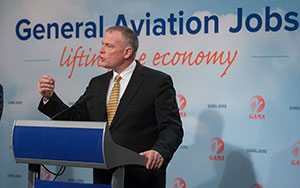
Standing in front of a backdrop stating: “General aviation jobs, lifting the economy,” General Aviation Manufacturers Association (GAMA) Chairman Aaron Hilkemann and GAMA President and CEO Pete Bunce on Feb. 10 highlighted the industry’s value to citizens, companies and communities across the U.S., by shining a spotlight on the important work of two aviation-based humanitarian groups, as part of GAMA’s annual “State of the Industry” report.
The role of business aviation in providing humanitarian lift for people in need is one of the central themes of the No Plane No Gain advocacy campaign, which is jointly sponsored by GAMA and the National Business Aviation Association. Read more about the industry’s humanitarian efforts.
As the campaign continually reminds policymakers and opinion leaders, companies using business aircraft routinely fly missions that transport patients with acute illnesses to treatment centers, reunite combat veterans with their families, provide relief for victims of natural disasters, and deliver other types of support for those in need.
A recent No Plane No Gain survey, conducted by Harris Poll, found that in 2015, 23 percent of business aircraft pilots said they had flown humanitarian missions, with the same pilots reporting they typically fly 3.5 humanitarian missions per year. Review the survey.
Recognizing the importance of such missions, Bunce took a moment during his Feb. 10 event to point to two groups he said represent “the greatest part of our industry,” given their focus on matching those with business airplanes to those in need of assistance.
He first praised the work of Veterans Airlift Command (VAC). The Minneapolis, MN-based organization provides free air transportation to post 9/11 combat-wounded veterans and their families for medical and other compassionate purposes. Bunce noted that 95 percent of VAC’s resources go directly toward its missions. In 2007, NBAA recognized the organization with the association’s Al Ueltschi Award for Humanitarian Leadership.
He also lauded the work of New York-based Corporate Angel Network (CAN), the only charitable organization in the country whose sole mission is to help cancer patients by arranging free travel to treatment across the country using empty seats on business jets. The group arranges more than 3,000 flights per year, and is expected to fly its 50,000th passenger this spring. CAN is the exclusive beneficiary of the annual “soiree” charity event, which takes place during NBAA’s Business Aviation Convention & Exhibition. Last year’s event raised more than $505,000 for the organization. NBAA honored CAN with the association’s Ueltschi award in 2008.
As per tradition, Hilkemann and Bunce also provided an overview of aircraft 2015 shipments and billings as part of the State of the Industry event.

Total worldwide GA airplane shipments fell 4.6 percent from 2,376 units in 2014 to 2,267 units in 2015. Billings for GA airplanes also dropped to $20.9 billion, down 4 percent from $21.8 billion in 2014.
Shipments of piston-engine airplanes fell for the first time since 2010, down 6.5 percent, from 1,129 units in 2014 to 1,056 units in 2015. Turboprop airplane shipments also declined, from 603 units in 2014 to 557 units in 2015, a 7.6 percent drop. Preliminary business jet shipments were relatively flat, up 1.6 percent, from 644 units in 2014 to 654 units in 2015.
Worldwide rotorcraft shipments fell 4.4 percent, from 998 units in 2014 to 954 units in 2015, while billings dipped 21.9 percent, from $4.9 billion to $3.8 billion. Shipments of piston helicopters rose 8.6 percent, from 257 units in 2014 to 279 units in 2015. Turbine helicopter shipments, based on initial data, softened from 741 units in 2014 to 675 units last year.
